Burn physical examination: Difference between revisions
EmanAlademi (talk | contribs) No edit summary |
EmanAlademi (talk | contribs) No edit summary |
||
| Line 9: | Line 9: | ||
'''The major factors to consider when evaluating the burned skin are the extent of the burns (usually calculated by the percentage of total body surface area (% TBSA) burned) and the estimated depth of the burns (superficial, partial thickness or full thickness).'''<ref name="pmid30320409">{{cite journal |vauthors=Grammatikopoulou MG, Theodoridis X, Gkiouras K, Stamouli EM, Mavrantoni ME, Dardavessis T, Bogdanos DP, Schmoldt A, Benthe HF, Haberland G, Holder AA, Wootton JC, Baron AJ, Chambers GK, Fincham JR, Longo DL, Herbert V |title=AGREEing on Guidelines for Nutrition Management of Adult Severe Burn Patients |journal=JPEN J Parenter Enteral Nutr |volume=43 |issue=4 |pages=490–496 |date=May 2019 |pmid=30320409 |doi=10.1002/jpen.1452 |url=}}</ref><ref name="pmid30089764">{{cite journal |vauthors=Watson C, Troynikov O, Lingard H |title=Design considerations for low-level risk personal protective clothing: a review |journal=Ind Health |volume=57 |issue=3 |pages=306–325 |date=June 2019 |pmid=30089764 |pmc=6546585 |doi=10.2486/indhealth.2018-0040 |url=}}</ref><ref name="pmid">{{cite journal |vauthors=Johnson SP, Chung KC |title=Outcomes Assessment After Hand Burns |journal= |volume= |issue= |pages=389–397 |date=May 2017 |pmid= |pmc=5380152 |doi=10.1016/j.hcl.2016.12.011 |url=}}</ref><ref name="pmid29733046">Beltran SL, Vilela RAG, de Almeida IM (2018) [https://www.ncbi.nlm.nih.gov/entrez/eutils/elink.fcgi?dbfrom=pubmed&retmode=ref&cmd=prlinks&id=29733046 Challenging the immediate causes: A work accident investigation in an oil refinery using organizational analysis.] ''Work'' 59 (4):617-636. [http://dx.doi.org/10.3233/WOR-182702 DOI:10.3233/WOR-182702] PMID: [https://pubmed.gov/PMID: 29733046 PMID: 29733046]</ref> | '''The major factors to consider when evaluating the burned skin are the extent of the burns (usually calculated by the percentage of total body surface area (% TBSA) burned) and the estimated depth of the burns (superficial, partial thickness or full thickness).'''<ref name="pmid30320409">{{cite journal |vauthors=Grammatikopoulou MG, Theodoridis X, Gkiouras K, Stamouli EM, Mavrantoni ME, Dardavessis T, Bogdanos DP, Schmoldt A, Benthe HF, Haberland G, Holder AA, Wootton JC, Baron AJ, Chambers GK, Fincham JR, Longo DL, Herbert V |title=AGREEing on Guidelines for Nutrition Management of Adult Severe Burn Patients |journal=JPEN J Parenter Enteral Nutr |volume=43 |issue=4 |pages=490–496 |date=May 2019 |pmid=30320409 |doi=10.1002/jpen.1452 |url=}}</ref><ref name="pmid30089764">{{cite journal |vauthors=Watson C, Troynikov O, Lingard H |title=Design considerations for low-level risk personal protective clothing: a review |journal=Ind Health |volume=57 |issue=3 |pages=306–325 |date=June 2019 |pmid=30089764 |pmc=6546585 |doi=10.2486/indhealth.2018-0040 |url=}}</ref><ref name="pmid">{{cite journal |vauthors=Johnson SP, Chung KC |title=Outcomes Assessment After Hand Burns |journal= |volume= |issue= |pages=389–397 |date=May 2017 |pmid= |pmc=5380152 |doi=10.1016/j.hcl.2016.12.011 |url=}}</ref><ref name="pmid29733046">Beltran SL, Vilela RAG, de Almeida IM (2018) [https://www.ncbi.nlm.nih.gov/entrez/eutils/elink.fcgi?dbfrom=pubmed&retmode=ref&cmd=prlinks&id=29733046 Challenging the immediate causes: A work accident investigation in an oil refinery using organizational analysis.] ''Work'' 59 (4):617-636. [http://dx.doi.org/10.3233/WOR-182702 DOI:10.3233/WOR-182702] PMID: [https://pubmed.gov/PMID: 29733046 PMID: 29733046]</ref><ref name="DevinckDeveaux2018">{{cite journal|last1=Devinck|first1=F.|last2=Deveaux|first2=C.|last3=Bennis|first3=Y.|last4=Deken-Delannoy|first4=V.|last5=Jeanne|first5=M.|last6=Martinot-Duquennoy|first6=V.|last7=Guerreschi|first7=P.|last8=Pasquesoone|first8=L.|title=Les brûlures profondes par agents basiques : évaluation d’une stratégie chirurgicale en deux temps|journal=Annales de Chirurgie Plastique Esthétique|volume=63|issue=3|year=2018|pages=191–196|issn=02941260|doi=10.1016/j.anplas.2018.03.008}}</ref> | ||
'''Extent of the Burn''' | '''Extent of the Burn''' | ||
| Line 15: | Line 15: | ||
'''Several methods are available to estimate the percentage of total body surface area burned.''' | '''Several methods are available to estimate the percentage of total body surface area burned.''' | ||
* '''''Rule of Nines'' - The head represents 9%, each arm is 9%, the anterior chest and abdomen are 18%, the posterior chest and back are 18%, each leg is 18%, and the perineum is 1%. For children, the head is 18%, and the legs are 13.5% each.''' | *'''''Rule of Nines'' - The head represents 9%, each arm is 9%, the anterior chest and abdomen are 18%, the posterior chest and back are 18%, each leg is 18%, and the perineum is 1%. For children, the head is 18%, and the legs are 13.5% each.''' | ||
* '''''Lund and Browder Chart'' – This is a more accurate method, especially in children, where each arm is 10%, anterior trunk and posterior trunk are each 13% and the percentage calculated for the head and legs varies based on the patient’s age.''' | *'''''Lund and Browder Chart'' – This is a more accurate method, especially in children, where each arm is 10%, anterior trunk and posterior trunk are each 13% and the percentage calculated for the head and legs varies based on the patient’s age.''' | ||
* '''''Palmar Surface'' - For small burns, the patient's palm surface (excluding the fingers) represents approximately 0.5% of their body surface area, and the hand surface (including the palm and fingers) represents about 1% of their body surface area. ''' | *'''''Palmar Surface'' - For small burns, the patient's palm surface (excluding the fingers) represents approximately 0.5% of their body surface area, and the hand surface (including the palm and fingers) represents about 1% of their body surface area. ''' | ||
=='''How is a burn evaluation used?'''== | =='''How is a burn evaluation used?'''== | ||
Revision as of 16:56, 29 September 2020
|
Burn Microchapters |
|
Diagnosis |
|---|
|
Treatment |
|
Case Studies |
|
Burn physical examination On the Web |
|
American Roentgen Ray Society Images of Burn physical examination |
|
Risk calculators and risk factors for Burn physical examination |
Editor-In-Chief: C. Michael Gibson, M.S., M.D. [1]
Please help WikiDoc by adding more content here. It's easy! Click here to learn about editing.
Physical Examination
Because most burns are small and classified as minor burns, the history and physical can proceed as usual. If the patient appears to have burns classified as severe, then the approach should be like that of a major trauma patient (see Burns, Resuscitation, and Management chapter). Key factors in the history include the type of burn, possible inhalation injury, and possible associated traumatic injuries. If possible, ask prehospital emergency services providers if the patient had prolonged smoke exposure (consider carbon monoxide poisoning, cyanide poisoning, lung injury) or might have other injuries from explosions, falls or jumping to safety. Examination of the burn can be done in the patient's secondary survey. The patient's clothing should be removed, and the patient should be examined from head to toe in a warm room
The major factors to consider when evaluating the burned skin are the extent of the burns (usually calculated by the percentage of total body surface area (% TBSA) burned) and the estimated depth of the burns (superficial, partial thickness or full thickness).[1][2][3][4][5]
Extent of the Burn
Several methods are available to estimate the percentage of total body surface area burned.
- Rule of Nines - The head represents 9%, each arm is 9%, the anterior chest and abdomen are 18%, the posterior chest and back are 18%, each leg is 18%, and the perineum is 1%. For children, the head is 18%, and the legs are 13.5% each.
- Lund and Browder Chart – This is a more accurate method, especially in children, where each arm is 10%, anterior trunk and posterior trunk are each 13% and the percentage calculated for the head and legs varies based on the patient’s age.
- Palmar Surface - For small burns, the patient's palm surface (excluding the fingers) represents approximately 0.5% of their body surface area, and the hand surface (including the palm and fingers) represents about 1% of their body surface area.
How is a burn evaluation used?
Burn evaluations are used to examine moderate to severe burn injuries. During a burn evaluation, your health care provider will carefully look at the wound. He or she will also figure out an estimated percentage of total body surface area (TBSA) that has been burned. Your provider may use a method known as the "rule of nines" to get this estimate. The rule of nines divides the body into sections of 9% or 18% (2 times 9). The sections are divided as follows:
- Head and neck: 9% of TBSA
- Each arm: 9% TBSA
- Each leg: 18% TBSA
- Anterior trunk (front of the body) 18% TBSA
- Posterior trunk (back of the body) 18% TBSA
Rule of nines estimates are not used for children. Their bodies have different proportions than adults. If your child has a burn that covers a medium to large area, your provider may use a chart, called a Lund-Browder chart, to make an estimate. This gives more accurate estimates based on a child's age and body size.
If you or your child has a burn that covers a small area, your provider may use an estimate based on the size of the palm, which is about 1% of TBSA.
What else happens during a burn evaluation?
If you have a serious burn injury, you may also need an emergency evaluation known as an ABCDE assessment. ABCDE assessments are used to check key body systems and functions. They often take place in ambulances, emergency rooms, and hospitals. They are used for different types of traumatic emergencies, including severe burns. "ABCDE" stands for the following checks:
- Airway. A health care provider will check for any blockages in your airway.
- Breathing. A provider will check for signs of trouble breathing, including coughing, rasping, or wheezing. The provider may use a stethoscope to monitor your breath sounds.
- Circulation. A provider will use devices to check your heart and blood pressure. He or she may insert a thin tube called a catheter into your vein. A catheter is a thin tube that carries fluids into your body. Burns can often cause serious fluid loss.
- Disability. A provider will check for signs of brain damage. This includes checking to see how you respond to different verbal and physical stimulation.
- Exposure. A provider will remove any chemicals or burn-causing substances from the skin by flushing the injured area with water. He or she may bandage the area with a sterile dressing. The provider will also check your temperature, and warm you with a blanket and warm fluids if necessary.[6]
Skin
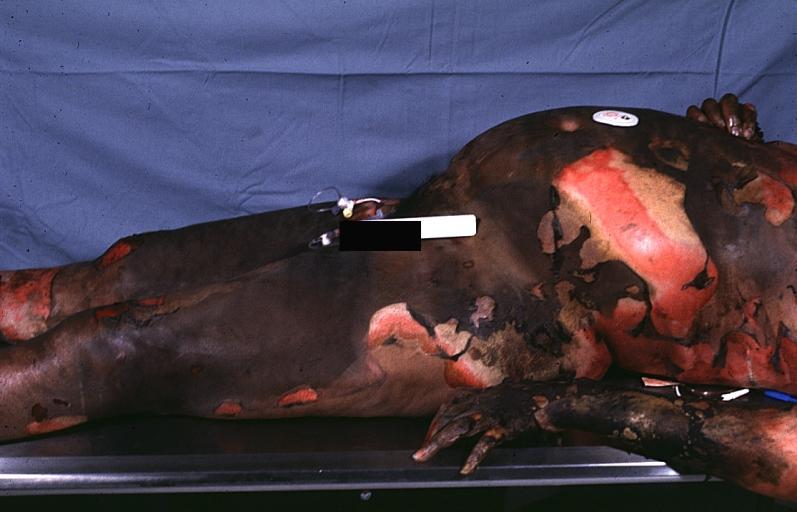 |
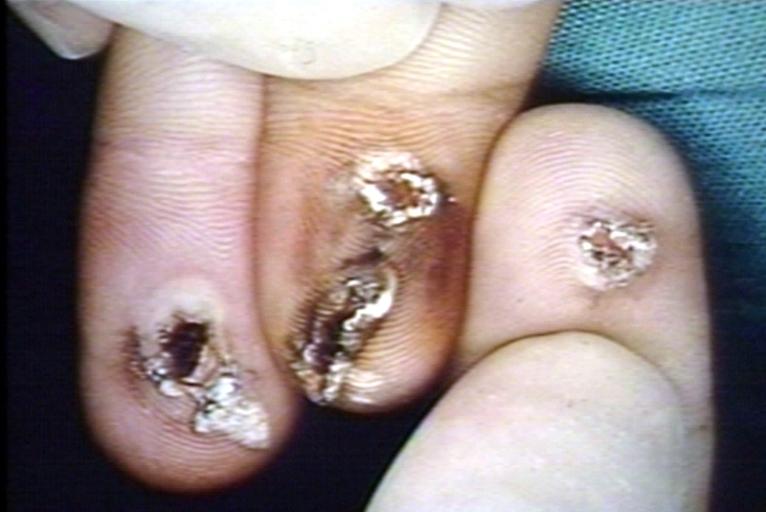 |
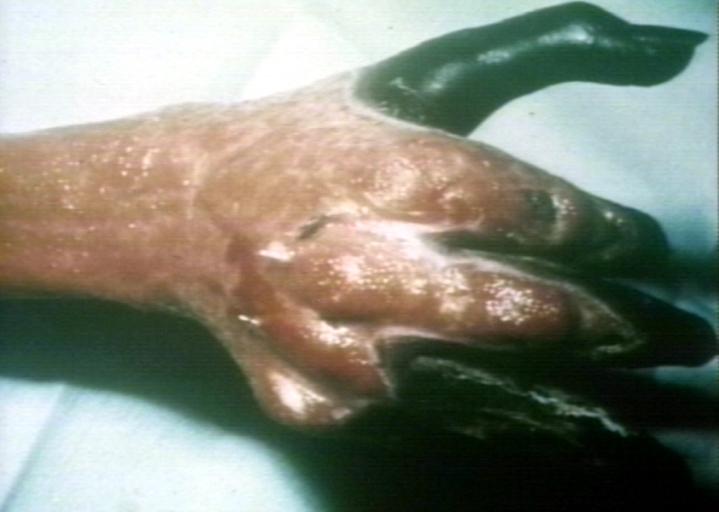 |
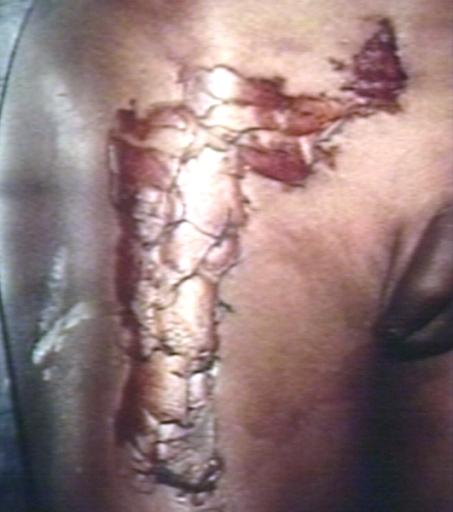 |
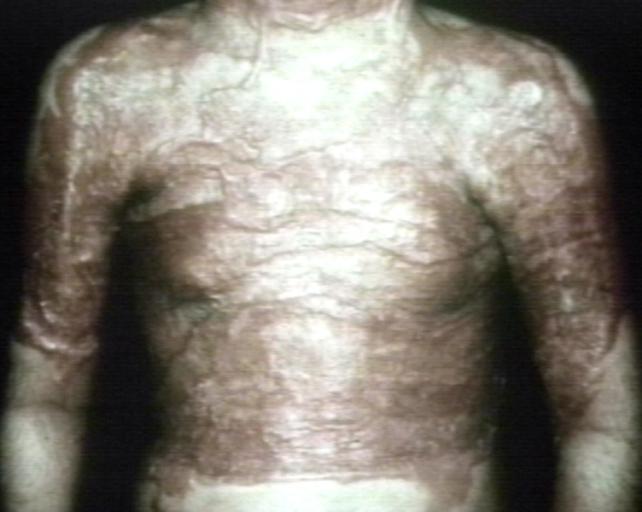 |
Head
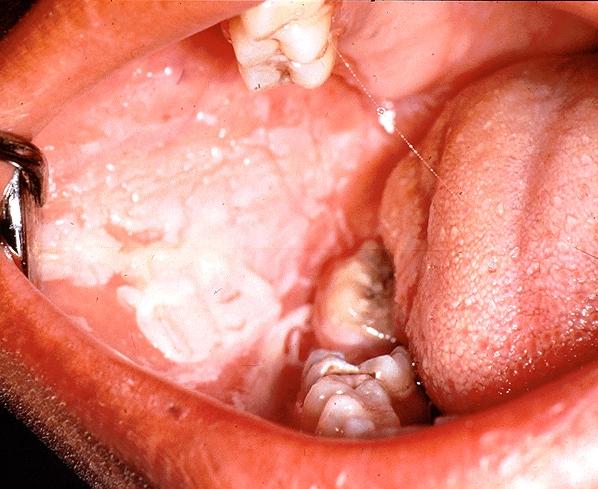
References
- ↑ Grammatikopoulou MG, Theodoridis X, Gkiouras K, Stamouli EM, Mavrantoni ME, Dardavessis T, Bogdanos DP, Schmoldt A, Benthe HF, Haberland G, Holder AA, Wootton JC, Baron AJ, Chambers GK, Fincham JR, Longo DL, Herbert V (May 2019). "AGREEing on Guidelines for Nutrition Management of Adult Severe Burn Patients". JPEN J Parenter Enteral Nutr. 43 (4): 490–496. doi:10.1002/jpen.1452. PMID 30320409.
- ↑ Watson C, Troynikov O, Lingard H (June 2019). "Design considerations for low-level risk personal protective clothing: a review". Ind Health. 57 (3): 306–325. doi:10.2486/indhealth.2018-0040. PMC 6546585 Check
|pmc=value (help). PMID 30089764. - ↑ Johnson SP, Chung KC (May 2017). "Outcomes Assessment After Hand Burns": 389–397. doi:10.1016/j.hcl.2016.12.011. PMC 5380152.
- ↑ Beltran SL, Vilela RAG, de Almeida IM (2018) Challenging the immediate causes: A work accident investigation in an oil refinery using organizational analysis. Work 59 (4):617-636. DOI:10.3233/WOR-182702 PMID: 29733046 PMID: 29733046
- ↑ Devinck, F.; Deveaux, C.; Bennis, Y.; Deken-Delannoy, V.; Jeanne, M.; Martinot-Duquennoy, V.; Guerreschi, P.; Pasquesoone, L. (2018). "Les brûlures profondes par agents basiques : évaluation d'une stratégie chirurgicale en deux temps". Annales de Chirurgie Plastique Esthétique. 63 (3): 191–196. doi:10.1016/j.anplas.2018.03.008. ISSN 0294-1260.
- ↑ "Burn Evaluation: MedlinePlus Medical Test".